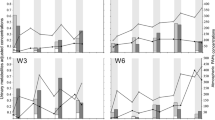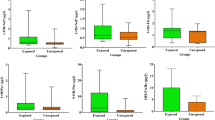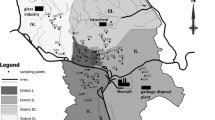Abstract
Objectives: The aim of the study was to assess the intake (by various routes of exposure) of polycyclic aromatic hydrocarbons (PAH) by children living in a Czech city, and its effect on excretion of 1-hydroxypyrene (1-OHP) in summer and winter periods. Methods: Four groups of children (3–6 years old) were chosen: (1) two groups from a kindergarten situated in the city center with a higher traffic density (“polluted” area); (2) two groups from a kindergarten situated in a green zone of the same city (“non-polluted” area). Food consumption was recorded in all children and PAH intake from foodstuffs was estimated. Ambient air samples were collected from the playground and inside the kindergartens. Soil samples were collected too. Morning and evening urine samples were collected during sampling days. Results: In both seasons, the mean outdoor total PAH concentration (sum of 12 individual PAH) in the “polluted” area was approximately three-times higher than that in the “non-polluted” area. Indoor concentration in the “polluted” area was more than six-times higher than that in the “non-polluted” area in summer, and almost three-times higher in winter. The same trend was observed for pyrene and for the sum of carcinogenic PAH. The contribution to the total pyrene absorbed dose from food consumption was much more important than that from inhalation and from ingestion of soil dust. Significantly higher urinary concentrations of 1-OHP (evening samples) were found in children from the “polluted” kindergarten in both seasons. The number of significant relationships between 1-OHP and pyrene absorbed dose was weak. Conclusions: Food seems to be the main source of total pyrene and total PAH intake in small children, even under relatively higher air PAH exposure in the city. Estimated pyrene ingestion from soil had a negligible contribution to the total pyrene absorbed dose. Urinary 1-OHP seems to be an uncertain (non-sensitive) marker of the environmental inhalation exposure to pyrene (PAH) if the pollution of air by pyrene (PAH) is not excessive and the pyrene (PAH) dose by this route is much less than by ingestion. Usefulness of the urinary 1-OHP as an indicator of overall environmental exposure to PAH needs further investigation.
Similar content being viewed by others
Author information
Authors and Affiliations
Additional information
Received: 18 September 2000 / Accepted: 20 February 2001
Rights and permissions
About this article
Cite this article
Fiala, Z., Vyskocil, A., Krajak, V. et al. Environmental exposure of small children to polycyclic aromatic hydrocarbons. Int Arch Occup Environ Health 74, 411–420 (2001). https://doi.org/10.1007/s004200100239
Issue Date:
DOI: https://doi.org/10.1007/s004200100239




